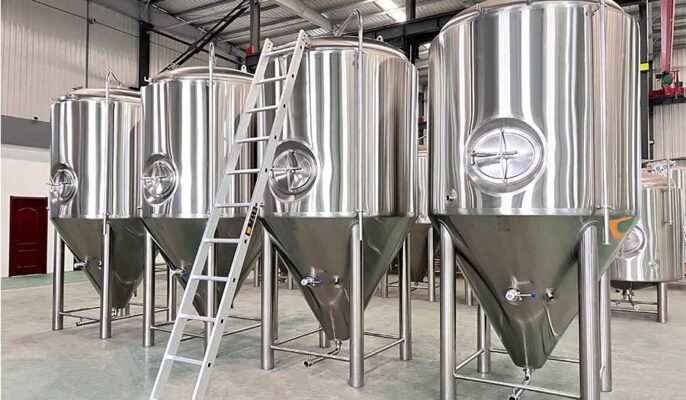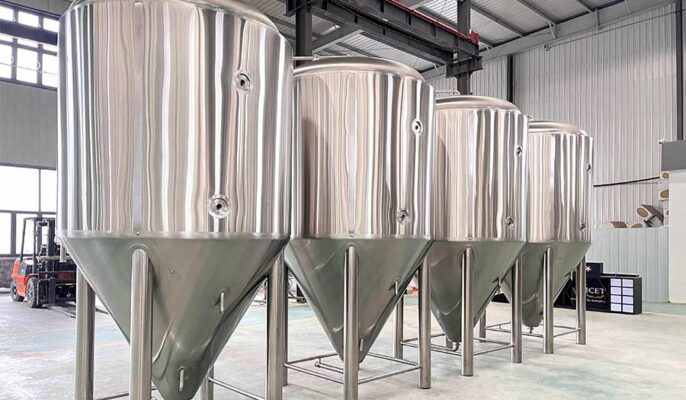Fermentation vessels, called fermenters or FVs, come in many types and materials. Tanques de fermentação are essential equipment for breweries. A fermenter is a container that holds a substrate such as wort or grape juice for fermentation. These tanks provide the necessary environment for yeast or other microorganisms to convert sugar into alcohol and carbon dioxide.
Diferentes tipos de tanques de fermentação
Wooden barrel fermentation tank
Wooden barrels are not the oldest fermentation vessels. This involves placing the wort into a barrel with your preferred yeast combination. The beer produced by this process is not to be confused with cask beer, which is fermented in separate tanks and then aged in barrels.
Barrel-fermented beer has the advantage of novelty and can impart some of the flavor qualities present in the barrel wood to the beer. But, it can be difficult to create, and winemakers often have limited control over it. This makes brewing consistent beer challenging.
Tanque de fermentação em plástico
Plastic fermenters, also known as carboys, are an cheap option for craft breweries, often used for small-scale or experimental batches. Made from food-grade plastic such as PET or HDPE, these tanks are lightweight and easy to transport.
One of the benefits of using plastic fermenters is that they are inexpensive compared to other options and can be replaced if damaged. They are also easy to clean and can be equipped with airlocks to release gases during fermentation. But, plastic fermentation tanks are not as durable as stainless steel or wooden tanks and are not suitable for the long-term aging of beer.
Ceramic fermentation tank
Ceramic fermenters, also known as amphorae, are a more traditional choice for craft breweries, often used to produce ancient and exotic beers. Made of ceramic, these jars are known for their ability to keep heat, which is useful during the fermentation process.
One of the benefits of using ceramic fermenters is that they are porous, allowing the beer to breathe and absorb oxygen during fermentation. This helps develop complex flavors and aromas in the finished product. Ceramic fermenters are also appealing and can add a unique touch to a brewery’s branding. But, they are fragile and prone to breakage, and their porous nature also makes them more susceptible to contamination if not cleaned and disinfected.
Concrete fermentation tank
Concrete fermenters are a new addition to the craft beer scene, often used to produce modern and experimental styles of beer. Made of concrete, these tanks are known for their ability to keep heat and have insulating properties, which are useful during the fermentation process.
One of the benefits of using concrete fermentation tanks is that they are very durable and can withstand the pressure and temperature changes that occur during the fermentation process. They are also corrosion-resistant and easy to clean, making them a hygienic choice for breweries. But, concrete fermenters are expensive to manufacture and install and must specialized equipment and expertise to handle.
Tanque de fermentação em aço inoxidável
Stainless steel fermenters are the most popular choice for craft breweries due to their durability and versatility. These tanks are made of high-quality stainless steel and can withstand the pressure and temperature changes that occur during fermentation. They are also corrosion-resistant and easy to clean, making them a hygienic choice for breweries.
One of the benefits of using stainless steel fermenters is that they can be used for both primary and secondary fermentations. Primary fermentation is the initial stage of fermentation where most fermentation occurs, while secondary fermentation is the second stage of fermentation and helps clarify and stabilize the beer. Stainless steel tanks can also be equipped with temperature control systems, allowing breweries to control the temperature of the fermentation process.

Tanque de fermentação types for different purposes
Tanque de fermentação aberto
Os fermentadores de topo aberto são recipientes simples sem tampas ou vedantes e são o tipo mais básico de fermentador. São utilizados para fermentar vinho porque permitem um acesso fácil e a prensagem manual da tampa (a camada de peles e sementes de uva que sobem à superfície durante a fermentação).
Tanque de fermentação fechado
Os fermentadores fechados têm uma tampa selada que impede a entrada de quaisquer contaminantes externos no processo de fermentação. São utilizados no fabrico de cerveja porque protegem o líquido da exposição ao ar, que pode causar deterioração ou sabores estranhos.
Tanque de fermentação de capacidade variável
Os fermentadores de capacidade variável têm tampas flutuantes e volumes ajustáveis, tornando-os adequados para fermentar diferentes quantidades de líquido. São populares entre os cervejeiros caseiros e os pequenos cervejeiros porque oferecem flexibilidade e ajudam a reduzir a quantidade de contacto do ar com o líquido em fermentação.
Fermentation tank function
- Temperature regulation: Many fermenters, especially closed fermenters, are equipped with temperature control systems. Maintaining the correct temperature is critical and affects the flavor profile and quality of the final product.
- Stirring and mixing: Some fermenters have built-in stirrers. Proper mixing ensures even fermentation, and better temperature control, and can enhance yeast health, especially in large tanks.
- Sealed environment: Protects fermented products from external contaminants such as wild yeast and bacteria.
- Sediment separation: The conical fermentation tank allows yeast and other sediments to settle to the bottom. This design simplifies the removal process and makes next filtration or racking stages more efficient.
Types of stainless steel fermentation tanks
Conical fermentation tan
Conical fermenters have a tapered bottom that allows sediment to collect at the bottom. They also have a valve on the bottom to transfer the beer to another container. These fermenters are ideal for those who want to avoid transferring beer with sediment. Conical fermenters are also ideal for dry hopping or adding fruit during fermentation.
Tanque de fermentação de fundo plano
Flat-bottom fermenters have a flat bottom and are generally less expensive than conical fermenters. They are also easier to clean and disinfect. But, they do not provide the same level of sediment collection as conical fermenters.
Flat-bottom fermenters are ideal for those who don’t have to worry about sediment and don’t want to spend too much money. They are also a good choice for those who want a simpler fermentation process.
Jacketed Fermentation Tank
Jacketed fermenters feature a double-walled design with an outer jacket to control temperature during the fermentation process. They are ideal for brewing beer or other beers that need precise temperature control.
Jacketed fermenters are also great for those who want to experiment with different temperatures during the fermentation process. They can be used for both hot and cold fermentations, making the brewing process more flexible.
Unitank fermentation tank
Unitank fermenters combine the features of conical fermenters and jacketed fermenters. They have a tapered bottom and a jacket for temperature control. They also come with a pressure relief valve, perfect for those who want to carbonate beer in the same container.
Unitank fermenters are more expensive than other types of fermenters, but they offer a more advanced and versatile fermentation process. They are ideal for professional brewers who want to produce high-quality beer and have greater control over the process.

Como escolher o fermentador certo?
- Size and Capacity: Consider the amount of fermentation you intend to do. For commercial businesses, estimating future expansion can also help determine tank size.
- Material: Most fermentation tanks are made of stainless steel because they are durable, corrosion-resistant, and easy to clean. But, some traditional fermentation methods may use wood or other materials.
- Temperature control: For many fermentable products, maintaining precise temperatures is critical. Integrated temperature control systems can meet such requirements.
In the world of fermentation, the equipment you choose plays a key role in determining the quality of your final product. When choosing a manufacturer, consider not only price but also factors such as after-sales support, warranty, and availability of replacement parts. Over the years, micet brewing equipment has also been far ahead. This not only ensures a high-quality product but can also be customized to meet the customer’s exact specifications.




